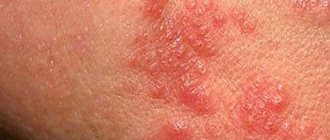Each person's intestines normally contain various microorganisms. In case of deviations of a qualitative or quantitative nature, we can talk about the occurrence of dysbacteriosis.
To describe such conditions, the terms dysbiosis, imbalance of microorganisms are used. In modern medicine, this condition is not classified as a disease. It is believed that this is simply an imbalance in the state of the body, which affects the manifestation of various symptoms. In this article we will look at what dysbiosis is and how to treat it.
Features of the bacterial background of the body
Abdominal cramps are a symptom of dysbiosis.
Normal flora includes bacteria that should be present in the body of every healthy person. They should be in the intestines, on the surface of the skin, in the mouth, in the nose, and in women - in the vagina.
Some microorganisms are classified as opportunistic. They received this name because they can cause harm to the body if they multiply in large numbers.
Under optimal conditions, normal flora should control the number of opportunistic microorganisms, as well as protect against the penetration of pathogenic bacteria into the body.
It is this mechanism that protects a person. As a result, the penetration of dangerous microorganisms into the body does not always lead to the development of a disease, because the normal flora has time to react adequately and prevent the colonization of pathogenic bacteria.
But if the normal flora is partially or completely destroyed, then infection occurs unhindered. And opportunistic microorganisms will multiply uncontrollably, provoking the development of many unpleasant symptoms. Most often, this phenomenon occurs precisely in the intestines and in the female genital organs (then they talk about vaginal dysbiosis).
Dysbacteriosis - symptoms and treatment
Symptoms of intestinal dysbiosis can hardly be distinguished from the symptoms of its complications. This is because dysbiosis is a syndrome that makes a significant contribution to the development of many diseases.
Complications can be divided into several groups:
- neuropsychiatric diseases : depression, Alzheimer's disease, multiple sclerosis, anxiety disorder, schizophrenia, autistic disorders, Parkinson's disease;
- diseases associated with insulin resistance : insulin resistance, dyslipidemia, obesity, type II diabetes mellitus, hypertension, non-alcoholic fatty liver disease[7];
- autoimmune pathologies : type I diabetes mellitus, rheumatoid arthritis, systemic lupus erythematosus, primary sclerosing cholagnitis[8];
- allergic diseases - bronchial asthma, atopic dermatitis, food allergy[9];
- systemic inflammation - Crohn's disease, ulcerative colitis, irritable bowel syndrome, celiac disease and colorectal cancer.
Neuropsychiatric diseases
Depression and anxiety disorders are correlated with the predominance of Firmicutes over Bacteroides[12].
Multiple sclerosis is associated with a significant reduction in Clostridia species XIVa and IV, an increase in Methanobrevibacter and Akkermansia, and a decrease in Butyricimonas[8].
In a mouse model of Alzheimer's disease, microbiota accumulate in amyloid plaques[13].
The connection between schizophrenia, autistic disorders and Parkinson's disease with dysbiosis has been proven. But there is still debate about whether this connection is primary or concomitant.
Autoimmune pathologies
Type I diabetes mellitus is associated with a positive correlation between autoantibodies and microflora - islet cells, Bacteriodes and Bilophila. A negative association was also found with Streptococcus and Ruminococcaceae. In addition, the spread of Faecalibacterium leads to a decrease in the level of glycated hemoglobin[8].
Rheumatoid arthritis is intensified due to molecular mimicry - the bacteria Prevotella copri, Parabacteroides sp. and Butyricimonas reproduce the structure of two autoantigens of the organism. As a result, there are much more antigens in the inflamed synovial tissue. And the more GNS antibodies, the more severe the symptoms of arthritis (8). Probiotics can be used to reduce pain, swelling and improve blood counts during various phases of arthritis[22].
Systemic lupus erythematosus is accompanied by a decrease in the species diversity of microflora. This increases the number of Ruminococcus gnavus bacteria fivefold. The amount of antibodies to these bacteria is directly related to disease activity[20].
Primary sclerosing cholagnitis is associated with a decrease in microflora diversity. Alpha diversity increases after fecal microbiota transplantation. Because of this, alkaline phosphatase decreases by more than half, which indicates the influence of microbiota on autoimmune processes in the liver ducts[21].
Allergic diseases
Bronchial asthma is associated with an increase in respiratory microflora - Haemophilus influenzae, streptococci, Moraxella bacteria - and a decrease in the intestinal microbiome - bifidobacteria, Akkermansia, Faecalibacterium, Morganella, Lactobacillus bacteria. Inhalation of “agricultural dust”, which is saturated with bacteria and their components, can weaken the allergic reaction.
Atopic dermatitis occurs when the skin is colonized by Staphylococcus aureus against a background of increased sensitivity of the immune system and disruption of the skin barrier. Superantigens of staphylococci increase the concentration of IgE - antibodies designed to protect the body from parasites. If antibodies are absent, antigens attack their own tissues and cause allergies - they activate Th2 / Th22 inflammatory lymphocytes and promote the appearance of dendritic cells[23].
The opposite effect is achieved with epidermal staphylococcus. It suppresses the production of CD4, white blood cells involved in the immune response. The membrane protein TLR-2, by binding to normal skin flora, stimulates the production of antimicrobial peptides and an increase in tight junctions, which strengthens the skin barrier.
Allergies to food appear when there is excessive diversity of microflora. Excessive gut microbial enrichment in 3-month-old infants increases the risk of developing food hypersensitivity by one year of age. When the intestines are enriched with microbes at 12 months, this no longer happens.
When the numbers of Ruminococcaceae and Lachnospiraceae bacteria increase, children develop milk allergies. If the flora is enriched with Firmicutes bacteria, including Clostridia, then the allergy may resolve by school age.
Peanut or tree nut allergies occur when microbial diversity is reduced and Bacteroidetes are increased. Allergy symptoms and diarrhea may be relieved by the presence or oral administration of 17 strains of Clostridia.
Systemic inflammation
Crohn's disease and ulcerative colitis occur due to an overly aggressive immune response to beneficial intestinal flora in genetically susceptible individuals. The breakdown of proteins, peptides and amino acids by flora in the distal colon leads to the formation of various biologically active metabolites that can affect the viability of epithelial cells. A decrease in the number of bacterial species that produce butyrate leads to excessive activation of toll receptors, which can impair immunity due to changes in gene activity.
Irritable bowel syndrome is associated with a decrease in the number of lactobacilli, bifidobacteria and an increase in the number of aerobes compared to anaerobes. This disruption of the microflora modifies pain and motor responses[12].
The microbiota in this case becomes both the cause and the target of intestinal motility disorders, visceral hypersensitivity and neuroimmune signals. This occurs due to disruption of the mucous barrier, activation of receptors to which bacteria attach, as well as dysfunction of the hypothalamic-pituitary-adrenal axis (HPA axis).
How does HPA axis dysfunction occur? Cytokines and excess short-chain fatty acids increase levels of cortisol, the stress hormone. It goes to the pituitary gland, hypothalamus, amygdala, hippocampus and prefrontal cortex. The return signal from the brain leads to changes in intestinal motility and sensitivity, the epithelial barrier and the production of neurotransmitters are disrupted in the form of an increased response to environmental factors.
Why is intestinal motility impaired? Microbiota modulates intestinal motor function. Its composition can change through toll and node receptors. As a result, the permeability of the intestinal wall increases, and bacterial metabolites gain access to the submucosa. This alters the expression of genes that are involved in smooth muscle function and neurotransmission. Normal E. coli enhances contraction of the colon, and pathogenic strains of E. coli disrupt the contractility of muscle cells and inhibit motility. Exposure to Lactobacillus rhamnosus significantly impairs acetylcholine-stimulated contraction.
Celiac disease is a unique autoimmune disease. It is caused by genetic factors DQ2/DQ8 and an environmental trigger - gluten, but they are not enough to cause the disease to develop. The trigger for celiac disease is a disruption of the microbiota in predisposed children at the time of introduction of complementary foods - high proportions of Firmicutes, Proteobacteria, Corynebacterium, Gemella, Clostridium, Enterobacteriaceae and Raoultella and lower proportions of Actinobacteria, Bifidobacterium[32].
Since gluten intolerance becomes more common in adulthood after many years of eating grains, environmental exposure becomes an additional factor in the development of celiac disease.
Colorectal cancer - rectal cancer - is also associated with microflora disturbances. Advanced dysbiosis triggers chronic inflammation. Because of this, host-produced antibacterial peptides, secretory IgA, mucins, cytokines or neurotransmitters accumulate. Also, the remains of damaged cells and many reactive forms of oxygen and nitrogen accumulate in the body. When copying errors occur during intestinal cell division (dysplasia), these substances contribute to malignant degeneration.
Cancer development occurs according to the “driver-passenger” model:
- “drivers” - certain strains of bacteria - disrupt the microenvironment of the mucous membrane, damaging DNA;
- “passengers” - pathological flora - after damage to the membrane, they colonize it, which leads to chronic inflammation, direct tissue damage and tumor formation[15].
Other complications of dysbiosis
The risk of contracting sexually transmitted diseases , including HIV infection, increases. In girls, this is facilitated by a deficiency of Lactobacillus bacteria, which produce lactic acid and hydrogen peroxide to protect against pathogenic microorganisms[29]. In men, the risk of acquiring HIV infection increases with a high concentration of anaerobic bacteria in the microbiota under the foreskin.
Threat of premature birth . In women before 24 weeks' gestation, lower vaginal levels of Lactobacillus crispatus and higher levels of BVAB1, Sneathia amnii, TM7-H1, Prevotella and nine additional taxa may serve as a marker of this risk[7].
Risk of developing cardiovascular diseases . Periodontal bacterial DNA has been found in atherosclerotic plaques in patients suffering from coronary heart disease and atherosclerosis. Bacteria can initiate or aggravate atherosclerotic processes. This activates the innate immune system, directly involving mediators that are activated by plaque antigens[15].
Risk of developing esophageal cancer - adenocarcinoma and squamous cell carcinoma. This risk is related to the composition of the oral microbiome. The periodontal pathogens Tannerella forsythia and Porphyromonas gingivalis are correlated with an increased risk of adenocarcinoma. A lower risk of this disease was observed due to depletion of the beneficial genus Neisseria and Streptococcus pneumoniae. There is also a relationship between bacterial biosynthesis of carotenoids and protection against the development of adenocarcinoma[27].
Signs of dysbiosis
Diarrhea is a common sign of dysbiosis.
Dysbacteriosis manifests itself in different ways. Each new case has its own set of signs. Among the most common are the following:
- diarrhea/constipation;
- flatulence, grumbling;
- nausea;
- spasms;
- allergies and other symptoms, including fever.
All this occurs against the background of phenomena caused by the underlying gastrointestinal disease, which usually leads to dysbacteriosis. Their similarity is obvious. Therefore, sometimes they do not immediately pay attention to this and make the appropriate diagnosis already at an advanced stage. After all, nausea and abdominal pain, deviations from the norm during bowel movements are elements of the clinical picture in almost all gastrointestinal diseases.
Symptoms of intestinal microflora disorders
Disturbances in the composition of the intestinal microflora do not manifest themselves immediately - alarming symptoms can bother a person for a long time. Ignoring them leads to the development of serious pathologies requiring medical intervention. Therefore, improper functioning of the gastrointestinal tract and other signs of the development of dysbiosis should be a reason for immediate action. Symptoms indicating an imbalance of intestinal microflora include:
- constipation and diarrhea;
- dyspeptic manifestations - excessive flatulence, nausea and belching, unpleasant breathing;
- changes in skin color and hair condition, brittle nails;
- allergic manifestations;
- vulnerability to depression, feelings of weakness and powerlessness.
Considering the interconnectedness of all internal processes in the body, intestinal dysbiosis invariably affects the functioning of other organs. The result of long-term disorders of the digestive processes are pathologies such as obesity, diseases of the cardiovascular system, poor health and decreased performance.
Diagnosis of dysbacteriosis
Laboratory examination of stool is a way to diagnose dysbiosis.
The main way to find out whether there is dysbacteriosis is to conduct a laboratory test of stool. With such diagnostics, the qualitative composition of the existing microorganisms and their quantitative ratio are determined.
To get an objective result, you must adhere to several rules for collecting stool. Firstly, sterile containers are used, available for sale in the pharmacy chain.
How to restore microflora
Normalization of intestinal microflora is facilitated by a balanced diet, including sufficient intake of carbohydrates, fats and proteins into the gastrointestinal tract. By carefully observing proper nutrition, a person ensures that the balance of beneficial microorganisms is maintained. This affects the functionality of all organs - the immune system works effectively, preventing infectious diseases, the acidity of the stomach is normalized, and vigor and activity are maintained.
Eating a nutritious diet may not be enough to restore the balance of beneficial bacteria. Doctors recommend solving the problem by taking medications - pharmacies widely stock products for restoring intestinal microflora. They are prescribed to treat dysbiosis and replenish the body with the necessary colonies of microbes.
Complete diet
A varied diet, including an abundance of fats and carbohydrates, helps restore and maintain intestinal microflora. The predominance of fiber in the diet, contained in legumes, grain bread, fruits, nuts and greens, enriches the composition of beneficial bacteria and reduces the number of pathogenic colonies. Inulin, a polysaccharide with a preobiotic effect, helps destroy pathogenic bacteria. The substance is present in large quantities in garlic, asparagus, onions, artichokes and chicory. The use of these products is recommended for intestinal infections and other manifestations of attacks by pathological microorganisms.
Bifidobacteria provide invaluable benefits to the intestinal microflora - they are present in blueberries and apples, pistachios and almonds. Doctors recommend taking care of their regular use for preventive purposes. This also applies to fermented foods - cabbage, yoghurt, kefir and kombucha. During fermentation, they are enriched with enzymes that quickly restore microflora and contribute to the rapid replenishment of the gastrointestinal tract with useful substances.
Probiotics
Science classifies probiotics as non-pathogenic microorganisms that help normalize intestinal microflora. During the use of probiotics, live bacteria penetrate the human gastrointestinal tract and neutralize pathogenic microbiota. Under normal conditions, beneficial microorganisms are present in the body in sufficient quantities, but if necessary, they can be replenished with the help of food and through the use of special medications.
The following probiotics are distinguished as part of the human microflora:
- bifidobacteria;
- lactobacilli;
- non-pathogenic microorganisms – enterococcus and Escherichia coli;
- yeast;
- lactic acid streptococci.
In the production of probiotic preparations, either probiotics of one type or representatives of several varieties can be used. They are also present in dairy and fermented milk products, while in the factory they can be additionally enriched with bifidobacteria and lactobacilli.
Prebiotics
Prebiotics are no less useful for the intestinal microflora, but due to their biological structure they differ in the direction of action. Consisting of lactulose, low molecular weight carbohydrates, insulin and fructose-oligosaccharides, prebiotics displace colonies of pathogenic microbes, restoring the condition of mucous membranes that have been damaged by infectious pathogens.
In nature, prebiotics are found in grains and legumes, vegetables and fruits, garlic and cereals. Their use normalizes microflora and protects people from cardiovascular pathologies, strokes and heart attacks. Taking medications with prebiotics helps reduce cholesterol, triglycerides and insulin.
Dysbiosis in childhood
Dysbacteriosis in children is a common occurrence.
Children are often susceptible to dysbiosis. In newborns, the lack of “beneficial” bacteria is considered a physiological condition, because at the moment of birth there are absolutely no microorganisms in his intestines.
The colonization of bacteria and their reproduction occurs little by little and, of course, unevenly. Therefore, during certain periods, certain bacteria may prevail over others.
Even if the baby is breastfed, he experiences a lot of overload associated with receiving new food. After all, he had never encountered anything like this in the prenatal state. Therefore, babies may suffer from fermentation and indigestion. But if a child has to eat formula, then dysbacteriosis is almost impossible for him to avoid.
But by 3–4 months the body will get used to such conditions and dysbiosis may disappear on its own, so treatment should not be carried out before this age. However, the process must be controlled by a doctor; it is he who makes the decision: to treat the child for dysbacteriosis or not.
Drugs and their action
The most effective way to restore microflora and get rid of dysbiosis is to use drugs from the group of probiotics. Manufacturers offer medicines in different forms:
- capsules;
- pills;
- powder;
- drops;
- solution.
The dosage form is selected by the doctor depending on the age of the patient. Children and elderly people who have difficulty swallowing tablets are prescribed a solution or powder for its preparation. At the age of 0-3 years, it is easier to give probiotic drops to a child. For everyone else, capsules or tablets are recommended.
Anti-dysbacteriosis medications are medications that can be purchased without a doctor's prescription. But self-medication is not recommended; only a specialist can tell you which type is best to take.
Probiotics usually contain 1-2 types of bacteria that restore mucous membranes well. Usually these are lacto- and bifidobacteria. They are normal inhabitants of the intestines that help improve microbial balance. The mechanism of action of this therapeutic group is associated with suppression of the growth of pathogenic flora. Lactic acid bacteria compete for receptors on the mucosal epithelium and nutrients. They secrete lactic acid and cytokines, which have an inhibitory effect on pathogens.
Preparations from the group of prebiotics help to effectively cure dysbiosis. These are medications that belong to the group of dietary fibers: inulin and lactulose, as well as drugs based on them.
They are not broken down by digestive enzymes and enter unchanged into the large intestine, where they become a nutrient substrate for lacto- and bifidobacteria. Therefore, microbes multiply well, increase the volume of bacterial mass, and restore the intestinal wall. To make the treatment as effective as possible, it is recommended to take prebiotics and probiotics at the same time.
Treatment of dysbiosis is not contraindicated in case of concomitant pathologies of the digestive tract. Probiotics are not harmful to patients with stomach ulcers, liver disease, or gallbladder disease. And in some cases they will speed up recovery.
In advanced cases of intestinal dysbiosis and when the symptoms of dyspepsia are too painful, medications from the group of enzymes can help. They should be selected by a doctor, depending on the type of digestive disorder. These medications must be taken daily before meals.
It’s hard to say how long it will take to treat dysbacteriosis. In some cases, this can last for several weeks, and in advanced cases – several months.
Main methods of treatment
In order for the treatment of dysbiosis to bear fruit, it is first necessary to identify and eliminate the cause that provoked its appearance. Therapeutic manipulations should be carried out in combination:
- diet;
- elimination of pathogenic microflora;
- colonization of the intestines with “good” microorganisms;
- strengthening the body (vitamins, immunostimulants).
Diet features
In case of dysbacteriosis, heavy foods are excluded.
For dysbiosis, a nutritious diet is recommended, enriching the body with a full range of essential substances. Heavy foods are excluded. Alcohol, sweets, animal fats, legumes, spicy and carbonated foods are prohibited.
At the same time, it is necessary to increase the amount of low-fat fermented milk products in the diet.
What is intestinal microflora?
The importance of bacteria inhabiting our body is well known to medicine - the vital activity of beneficial microorganisms contributes to many of the most important processes of digestion and the formation of immunity. The set of microbes that have a beneficial effect is included in the concept of intestinal microflora.
Beneficial microflora performs many functions:
- normalizes digestive processes - promotes the digestion of food and the breakdown of its residues;
- ensures the absorption of microelements by the gastrointestinal tract;
- participates in the synthesis of vitamins - the formation of B groups, biotin, vitamin K and folic acid occurs in the large intestine;
- suppresses pathogenic microorganisms - beneficial strains of microorganisms resist the growth and reproduction of harmful bacteria, stimulate the protective reactions of the immune system;
- accelerates intestinal peristalsis - normal microflora ensures the functioning of the gastrointestinal tract without failures or discomfort.
The close interaction of processes occurring in the intestines with brain activity has been proven. When microflora is disturbed, a person is characterized by psycho-emotional changes - he is overcome by a depressive mood and irritability.
Other examination methods
There is another, less common, but more accurate and faster method of microbiological examination - chromatography-mass spectrometry of microbial markers (CMS, or as it is also called MSMM). It was developed by Doctor of Biological Sciences G.A. Osipov and is used in some laboratories.
This method allows you to study the microbiological composition of various biological materials - blood, urine, saliva, vaginal discharge, etc. The analysis is carried out within 3 hours and allows you to determine the presence of 50 microorganisms in the test material without inoculation, using the so-called signal molecules (microbial markers).
Causes of dysbiosis when taking antibiotics
The sensitivity of microflora to antibiotics is not selective. Even modern drugs with antibacterial activity are not able to act only on individual pathogenic microorganisms. Medicinal drugs that are used to treat infectious diseases destroy not only pathogens, but also positive intestinal microflora. The result of this process is dysbiosis. In order to avoid the negative consequences of antibiotic therapy, it is necessary to use additional methods to maintain the balance of normal intestinal microbiota.
Causes
The reasons for the weakening of beneficial intestinal flora can be the following factors:
- Antibiotics. The entry of antibiotics into the intestinal tract increases the proliferation of pathogenic microbes and fungi. Dysbacteriosis manifests itself especially strongly after taking broad-spectrum antibiotics.
- Unbalanced diet. An incorrect diet leads to an imbalance of flora if animal proteins and fats predominate in the food, while fermented milk products, fresh fruits and vegetables are absent. The processes of rotting and fermentation cause the death of normal flora and the development of pathogenic bacteria.
- Radiation treatment, chemotherapy . Potent medical procedures greatly reduce the immune system, as a result of which the normal flora in the intestines is disrupted.
- Acute intestinal infections. For example, dysentery kills beneficial flora, helping harmful bacteria to develop.
- Parasites in the gastrointestinal tract. For example, roundworms produce toxins that kill normal microorganisms.
- Conditions that weaken the immune system. Serious diseases (oncology, diabetes), the elderly and children.
Stool analysis for dysbacteriosis
The most common examination method is a routine stool test for dysbacteriosis. It shows the composition of the microflora only in the lumen of the large intestine. The ratio of beneficial, opportunistic and pathogenic microorganisms is assessed. The analysis is carried out within 5-7 days.
How to get tested . The feces should be collected in a sterile container and taken to the laboratory as quickly as possible (no more than 2-3 hours). The faster the study is carried out, the more reliable the results will be. You cannot give rectal suppositories or an enema the day before the test.








